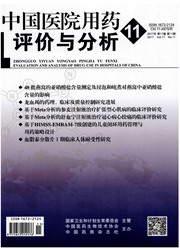

 中文摘要:
中文摘要:
目的:了解疏血通注射液与血塞通注射液的不良反应,分析影响因素,为临床安全使用这2种中药注射剂提供参考数据。方法:采用回顾性研究方法,对2007—2012年我院收集的疏血通注射液与血塞通注射液50例药品不良反应(ADR)报告进行统计、分析。结果:30例疏血通注射液ADR报告中,〉60岁患者11例,占36.67%;患者原患疾病为脑梗死者16例,占53.33%;ADR发生时间在1 d后的为16例,占53.33%;ADR累及多个器官和(或)系统,其中以皮肤及其附件损害为主。20例血塞通注射液ADR报告中,〉60岁患者5例,占25.00%,男女比例为1.86∶1;原患疾病8例为外伤,占40.00%;ADR发生时间在1 d后的为13例,占65.00%;ADR累及多个系统和(或)器官,主要以皮肤及其附件损害为主。结论:必须加强对疏血通注射液和血塞通注射液不良反应的监测工作,降低出现不良反应的可能性。
 英文摘要:
英文摘要:
OBJECTIVE: To investigate the adverse drug reactions (ADR) induced by Shuxuetong injection or Xuesaitong injection and analyze the associated factors in order to provide reference data for clinical safe use of these two kinds of traditional Chinese medicine injections. METHODS : By a retrospective study, a total of 50 cases of ADRs induced by Shuxuetong injection or Xuesaitong injection collected in our hospital during 2007-2012 were analyzed statistically. RESULTS: Of the 30 ADR cases induced by Shuxuetong injection, 11 cases (36.67%) aged 〉 60 years; 16 cases (53.33%) had the primary disease of cerebral infarction; the ADR in 16 (53.33%) occurred at 1 day after drug administration; multiple organs and (or) systems were involved in the ADR, with lesion of the skin and its appendages showing the highest proportion. Of the 20 ADR cases induced by Xuesaitong injection, 5 cases (25.00%) aged 〉 60 years with male to female ratio of 1.86:1 ; the primary disease in 8 cases (40. 00% ) was trauma; ADR in 13 (65.00%) occurred at 1 day after drug administration; multiple organs and (or) systems were involved in the ADR, with lesion of the skin and its appendages showing the highest proportion. CONCLUSION : It is important to strengthen monitoring on the adverse drug reactions (ADR) induced by Shuxuetong injection or Xuesaitong injection so as to reduce the likelihood of adverse reactions.
 同期刊论文项目
同期刊论文项目
 同项目期刊论文
同项目期刊论文
 期刊信息
期刊信息
